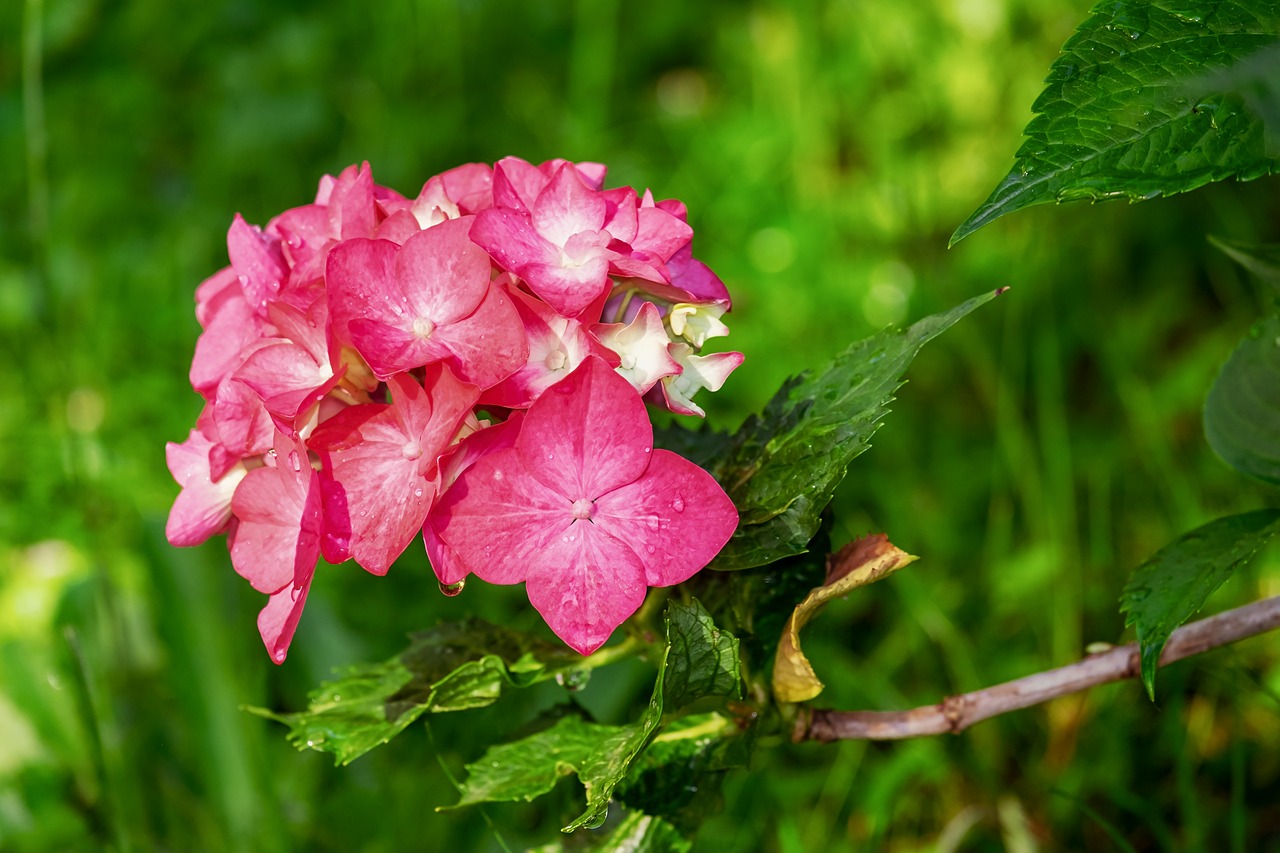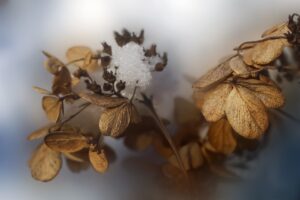Hydrangea
Overview
The Hydrangea plant is a charismatic addition to any garden, boasting lush, large blooms that capture the eye with hues of pink, blue, and purple. Its simple requirements and versatility in various soils make it a gardener’s delight, yet its beauty comes with a caution—its toxicity to pets necessitates a mindful planting.

Characteristics
Known for its large, vibrant flowers that can change color based on soil pH, and its adaptability to various growing conditions.
Region
Native to southern and eastern Asia and the Americas; widely grown in temperate regions worldwide.
Natural Habitat
Forest edges, stream banks, and mountainous regions.
Cultivation
Prefers full sun to partial shade, consistently moist humus-rich soil without waterlogging, and tolerates most soil types.
Uses and Benefits
The Hydrangea herb enchants us predominantly through its ornamental charm. With lush, large blooms that can switch hues depending on the soil’s pH levels, it brings a splash of color to gardens and homes alike3. These stunning flowers add a delightful focal point to any space.
While its main use is decorative, it’s worth noting that Hydrangea should be enjoyed with a bit of care—as it is toxic to pets. If you share your space with furry friends, you’ll want to ensure these plants are out of their reach to keep your pets safe2.
The Hydrangea’s versatility extends beyond its aesthetic appeal:
- Adapts readily to various soils
- Can flourish with the right combination of sunlight and moisture4
To nurture these beauties, understanding their needs is key:
- Provide a balance of sun and shade
- Water adequately without overdoing it
- Trust your gardener’s intuition
In short, the Hydrangea’s benefits are mostly visual—a testament to nature’s artistry that requires a touch of vigilance if you’ve got curious animals wandering about2. Whether you aim to create a focal point in your garden or add a natural burst of color to your living space, Hydrangeas stand as a breathtaking choice.

Cultivation Tips
To grow healthy and happy hydrangeas, place them in a spot where they can bask in full sunshine if the climate is gentle, or where they get morning light and afternoon shade in hotter zones.
Ensure they’re planted in humus-rich soil, as they love their roots to have a feast on organic material, but remember that good drainage is key—hydrangeas don’t appreciate soggy feet! When pruning, aim to remove only the older flowers and dead branches to encourage new growth.
Fertilize them in spring and summer to boost those big, bold blooms, and for a bit of magic, alter the soil’s pH to swing their color from pink to blue, or vice versa. Water them regularly, keeping the soil moist but not waterlogged1.
With just a little attention, your hydrangeas will transform your garden into a dazzling show of colors. Some additional cultivation tips include:
- Mulch around the base of the plant to retain moisture and suppress weeds
- Protect hydrangeas from harsh winds and extreme temperatures
- Deadhead spent blooms to encourage continuous flowering
- Prune at the right time based on your hydrangea variety (e.g., prune mophead and lacecap hydrangeas in late winter or early spring)
By following these simple care guidelines, you’ll be rewarded with healthy, vibrant hydrangeas that add beauty and charm to your garden for years to come.
Seasonal Considerations
To ensure your hydrangeas thrive through the seasons, consider these key factors:
- Spring: As the weather warms up, give your hydrangeas a boost by fertilizing them with a balanced, slow-release fertilizer. This will encourage healthy growth and abundant blooms. Prune away any dead or damaged branches to make room for new growth.
- Summer: Hydrangeas are thirsty plants, so keep the soil consistently moist, especially during hot and dry spells. Mulch around the base of the plant to help retain moisture and regulate soil temperature. If you want to change the color of your hydrangea blooms, now is the time to adjust the soil pH – add aluminum sulfate for blue flowers or lime for pink ones.
- Fall: As the days grow shorter and cooler, hydrangeas will start to prepare for dormancy. Gradually reduce watering and avoid fertilizing, as this can stimulate new growth that may not harden off before winter. Leave the faded blooms on the plant to provide winter interest and protect the buds beneath them.
- Winter: In colder regions, protect your hydrangeas from harsh winter weather by covering them with a layer of mulch or burlap. This will insulate the roots and prevent damage from freezing temperatures. In milder climates, simply remove any dead or damaged branches and leave the rest of the plant intact1.
By following these seasonal care tips, you’ll be rewarded with healthy, vibrant hydrangeas that add beauty and charm to your garden year after year.

Issues and Troubleshooting
Despite their resiliency, hydrangeas can encounter a few hiccups now and then. Overwatering can lead to root rot, while underwatering may cause wilted leaves and blooms. To combat this, ensure the soil is moist but well-drained to foster healthy plant growth2.
If the leaves of your hydrangea are turning yellow, it could be signaling a nutrient deficiency—often iron. This is typically corrected with soil amendments or fertilizers designed for acid-loving plants1. Pests such as aphids, spider mites, and slugs can also be a nuisance, but these can usually be controlled with insecticidal soaps or natural predators2.
Lastly, the anticipated bloom color might not materialize if the soil pH isn’t within the desired range for color expression. A soil test can guide you in adjusting the pH to achieve those stunning blue or pink flowers hydrangeas are celebrated for3. Just remember, patience is key; changes in soil chemistry take time to influence the hydrangea’s hues.
To troubleshoot common hydrangea issues, consider the following tips:
- Ensure proper watering by checking soil moisture regularly
- Address nutrient deficiencies with targeted fertilizers or soil amendments
- Control pests using insecticidal soaps or encouraging natural predators
- Test soil pH and adjust accordingly for desired bloom colors
By keeping a watchful eye on your hydrangeas and addressing issues promptly, you can help these beautiful plants thrive in your garden for years to come.
History and Folklore
With origins stretching back to ancient times, hydrangeas have not only graced the gardens of many but also carried with them a trove of folklore and symbolic meanings. Native to Asia and the Americas, these plants have been especially significant in Japan, where according to a legend, an emperor gifted hydrangeas to the family of a girl he loved to express his apologies for neglecting her3.
In some western cultures, hydrangeas have had a less romantic connotation, being associated with boastfulness or vanity, perhaps reflecting their showy and abundant blossoms1. This symbolism arises from the ability of hydrangeas to change their color, often seen as fickleness.
However, there is also a sweeter Victorian-era notion that hydrangeas expressed the giver’s gratefulness for being understood by the recipient. The history of hydrangeas is indeed as rich and varied as their hues—intertwined with the tales of many cultures across the globe1.
- In Japan, hydrangeas are linked to a touching tale of love and apology
- Western cultures have associated hydrangeas with both negative and positive traits
- The color-changing ability of hydrangeas has contributed to their symbolic meanings
References
1. Monrovia. “Hydrangea Care Guide: Expert tips for growing confidently.” https://www.monrovia.com/be-inspired/hydrangea-care-guide.html
2. The Spruce. “How to Grow and Care for Hydrangeas.” https://www.thespruce.com/growing-hydrangeas-1402684
3. Gardenia. “Hydrangea: How to Grow and Care with Success.” https://www.gardenia.net/guide/hydrangea-plant-care-and-growing-guide
4. The Old Farmer. “Hydrangeas: How to Plant and Care for Hydrangea Shrubs.” https://www.almanac.com/plant/hydrangeas
5. Gilmour. “Hydrangea Care: How to Plant, Grow & Care for Hydrangeas.” https://gilmour.com/hydrangea-care
Nicolas Duval
Nicolas is a passionate advocate for nature and the art of wildcrafting. His dedication shines through in Wildcraftia, a website he meticulously crafted to serve as a haven for nature enthusiasts worldwide. Driven by a deep appreciation for nature’s connection to humanity, Nicolas embarked on his journey in 2011 with SmokableHerbs, a platform showcasing his love for nature’s bounty. Building upon this foundation, he established Smokably, a thriving online store offering premium herbs and blends to a global audience.
